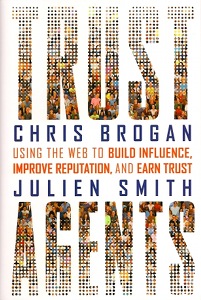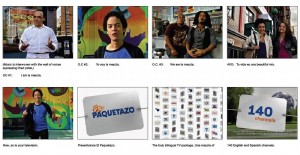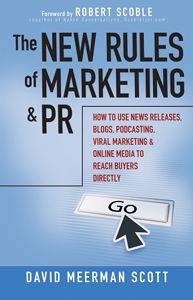Posted by Elena del Valle on September 28, 2009

Lon Safko, co-author, The Social Media Bible
Photo: Lon Safko
A podcast interview with Author Lon Safko is available in the Podcast Section of Hispanic Marketing & Public Relations, HispanicMPR.com. During the podcast, Lon discusses social media issues and his book with Elena del Valle, host of the HispanicMPR.com podcast.
Lon is the creator of the “First Computer To Save A Human Life.” That computer, along with 18 inventions and more than 30,000 of Lon‘s papers, is in the Smithsonian in Washington, D.C. He created numerous hardware and software solutions for the physically challenged, developed the first CAD software for civil engineers, and designed the archetypes for the Apple Newton and Microsoft’s Bob Operating Systems.
He is also responsible for the Tool-Tips help-balloon pop-ups. Some of the awards Lon has received include: Westinghouse Entrepreneur of the Year, Arizona Innovation Network’s Innovator of the Year, Arizona Software Association’s Entrepreneur of the Year, and Public Relations Society of America’s Edward Bernays Mark of Excellence Award.
Lon is the founder of nine companies, including Paper Models, Inc., which uses downloadable three-dimensional models in business advertising, promotions, and education. He has authored five books on: how to train managers to think creatively, how to launch a successful on-line business, and how new home owners can reduce building costs. His latest book The Social Media Bible Tactics, Tools, and Strategies for Business Success (see Business men outline social media basics…) addresses social media tools such as Facebook and YouTube.
To listen to the interview, scroll down until you see “Podcast” on the right hand side, then select “HMPR Lon Safko” click on the play button below or download the MP3 file to your iPod or MP3 player to listen on the go, in your car or at home. To download it, click on the arrow of the recording you wish to copy and save it to disk. The podcast will remain listed in the September 2009 section of the podcast archive.

Click here to buy The Social Media Bible
Posted by Elena del Valle on September 25, 2009

Trust Agents book cover
Chris Brogan and Julien Smith believe the Internet has changed the nature of business relationships. While researching information is faster and more efficient with the advent of the Internet, unreliable websites, spam, blam and other suspect communication tools make it hard to trust online and related sources. Reaching out to strangers or responding to their outreach efforts in the virtual world is challenging, they say. Winning over customers who are increasingly unwilling to respond to traditional media strategies and often are suspicious of expert claims requires a new approach, according to them.
They outline their thoughts on these issues in their newly published 271-page book, Trust Agents Using the Web to Build Influence, Improve Reputation, and Earn Trust (Wiley, $24.95). In the hardcover book Brogan and Smith discuss how the they think the web has become more humanized. Brogan indicates that “the people who succeed in understanding this and using the web to build businesses are called trust agents.”
In the book, an introduction and eight chapters focus on six characteristics and skill sets: standing out, belonging, having leverage, developing access, understanding, and establishing a network of contacts and relationships. The two co-authors discuss how readers can become trust agents, and make software, resources and tool recommendations. The chapter are titles as follows: Trust, Social Capital and Media; Make Your Own Game; One of Us; Archimedes Effect; Agent Zero; Human Artist; Build an Army; and The Trust Agent.

Julien Smith, co-author, Trust Agents
Brogan, who has been blogging since 1998, is co-founder of Podcamp, a new media conference series on the use of social media to build business and personal relationships. Smith, a trend analyst, has run web communities for 10 years. A resident of Montreal, Canada and he has been podcasting since 2004.

Click here to buy Trust Agents
Comments:
Filed Under: Books
Posted by Elena del Valle on September 23, 2009

Time Warner Cable El Paquetazo board - click to enlarge
Photo: Gotham, Inc.
Earlier this year, the cable operator hired Gotham Inc., a New York-based advertising firm, to spread the word about the launch of El Paquetazo, is new bilingual entertainment brand, to bilingual families in New York. El Paquetazo was launched in Los Angeles first. Gotham relied on broadcast, radio, and grassroots community-driven efforts with the tag line I am La Mezcla (Spanish for I am the mix), to introduce the brand in the Big Apple.
“El Paquetazo is unique as it an entertainment package built from the ground up for the Latino American consumer. Blending Spanish and English entertainment seamlessly much like the community itself moves seamlessly between Spanish and English creating its own unique mix,” said Peter McGuinness, chief executive officer of Gotham, in a press release.
El Paquetazo is a package of 140 of the Spanish and English language channels, including news, comedy, sports, music and family as well as channels from Colombia, Mexico and Puerto Rico. No further information was available according to a company representative.
Gotham, a 160-employee company, provides communication services for clients in fashion and beauty, retail, healthcare, financial services, and packaged goods such as: Lindt, Fresh Direct, Yellowbook.com, Sony Ericsson, Bausch & Lomb, Maybelline, Remington, RSM McGladrey and Newman’s Own. The Time Warner mission according to the company website is to “Connect people and businesses with information, entertainment and each other. Give customers control in ways that are simple and easy.”
Reach Hispanics online today with
“Marketing to Hispanics Online” audio recording
Identifying and characterizing the booming Hispanic online market



Joel Bary, Alex Carvallo and Matias Perel
Find out about
• The 16 million Latino online users
• Latino online users by gender
• What they do online
• Their language preferences
• How to reach Hispanic urban youth online
• What affects their online behavior
• What influences their purchases
Click here for information about “Marketing to Hispanics Online”
Comments:
Filed Under: Media
Posted by Elena del Valle on September 21, 2009

Luis Silberwasser, SVP and GM, Discovery Networks U.S. Hispanic Group
Photo, video: Discovery en Español
Discovery en Español will celebrate Hispanic Heritage Month 2009 with four original productions scheduled to begin airing September 20 and continue every Sunday night at 9 pm E/P during Hispanic Heritage Month (traditionally celebrated September 15 to October 15 see Getting Ready for Hispanic Heritage Month). The theme for this year is the optimism, determination, perseverance and courage of Hispanics to survive and conquer adversity. Scroll down to watch a Discovery en español video in Spanish about the 2009 Hispanic Heritage Month campaign.
The programs will explore the pilgrimage that transformed the lives of field workers and gave rise to César Chávez, a well known Latino leader, in La Marcha de las Uvas. Un Continente Tiembla, Vivir Para Contarlo, and Atrapados, focus on the fighting spirit of Latinos and their a shared drive and aspirations.
“During Hispanic Heritage Month, we look to offer our audience programming that is objective, enriching, and relevant. This Hispanic Heritage Month Discovery en Español will celebrate Hispanics, not only through original programming, but also via a national sweepstakes that will offer one lucky winner the chance to get a head start and to make his or her dreams come true,” said Luis Silberwasser, senior vice president and general manager of Discovery Networks U.S. Hispanic Group.
La Marcha de las Uvas, scheduled to air Sunday, September 20 at 9 p.m. is a one-hour special about Hispanic farm workers’ fight for equality in March of 1966 in Delano’s Fields, California. At that time, 70 grape pickers left the field to protest accompanied by the banner of the Virgin of Guadalupe and led by a humble farmer. The march culminated 25 days later, in Sacramento, with 10,000 people. The program name means The March of the Grapes in Spanish. The production required nine months and was filmed mostly in Delano and Sacramento, California by Eye Works/Cuatro Cabezas under the supervision of Michela Giorelli, director of production and development, Discovery en español.
Un Continente Tiembla, scheduled to air the following Sunday at the same time is a documentary about some of the worst natural disasters of Latin America. The goal of the program is to capture the spirit of survival of that region’s inhabitants. Using archival footage and dramatizations the producers showcase people’s resourcefulness when dealing with earthquakes and volcanic eruptions in Venezuela, Colombia, Peru, Guatemala, El Salvador, Mexico and Chile.
Atrapados airs the first Sunday in October and shares the story of 65 miners who died after an explosion at a coal mine in Mexico. The producers address the dangers of mining, what they believe may be one of the world’s most dangerous industries. The human story of the Mexican disaster is the central theme of the program which examines what happened at the Pasta de Conchos mine in Coahuila; how the trapped miners were cut off behind caved-in roofs with insufficient oxygen, and how and why the rescue workers, even after days of courageous efforts, were unable to reach them in time.
A series of six episodes,Vivir para Contarlo, is scheduled to begin airing Sunday, October 11) at 9 p.m. It is about some of the most terrible tragedies in Latin America, from the view point of the survivors, the rescue teams and the journalists who covered them. Each of the episodes will cover one particular tragedy, mixing archival footage, interviews, where-are-they-now sequences and dramatization. The series begins with Avalancha, Spanish for Avalanche, and runs every Thursday starting on October 29.
Starting on September 15, the Spanish language network will invite viewers to participate in its national Dreams come True initiative, which incorporates a sweepstakes and a virtual online share at discoveryenespanol.com. On the website visitors are in invited to exchange stories of aspiration and triumph via video and photo uploads.
Executives hope to receive submissions online that illustrate the dreams and achievements of Hispanics in the United States. They also anticipate 8 million impressions. Visitors can register for a chance to win a $5,000 cash prize towards a dream of their choice by calling 1.877.345.GANA or visiting the network’s website before midnight on October 15, 2009.
Discovery en Español, the Spanish-language voice of Discovery, offers Spanish speaking viewers in the United States science and technology, world culture and history, nature and wildlife and real-life drama from a selection of the Discovery networks and in house original Spanish-language content.
Posted by Elena del Valle on September 18, 2009

Twitter Tips, Tricks and Tweets book cover
In Twitter Tips, Tricks and Tweets (Wiley, $19.99) Toronto resident Paul McFedries shares step by step insights on Twitter. He wrote the book for beginners and those who have been Twitter fans and want to expand their knowledge. The book is filled with photos of the website and related media illustrating the author’s text and instructions. He starts out with very basic information to introduce first time users to Twitter, the growing and increasingly popular social media website.
From there he progresses, explaining how to add a picture, theme and background image to an account; send account updates; manage the 140-character limit and use non standard characters; follow Twitter etiquette; make updates private; use hashtags; find and follow people; retweet; understand and use Twitter’s mobile phone feature; find information on Twitter; use Twitter Scan, Twitterfall, TweetGrid, Monitter and others; share your Twitter presence and updates on other websites; use TweetDeck, twhirl, and Twitter websites like iTweet, Tweetree, and Tweetvisor; use Twitter gadgets and widgets; use tools to extend Twitter by shortening URLs, sharing photos, videos and music; post to multiple social networks; follow Twitter trends; and get your Twitter account ranking.
The 249-page paperback book is divided into nine chapters: How Do I Get Started with Twitter? What Can I Do to Customize My Twitter Profile? How Do I Send Twitter Updates? How Do I Follow Other Twitter Users? Can I Use Twitter on My Mobile Phone? How Do I Find Stuff in Twitter? Where Can I Display My Twitter Feed? How Can I Take Twitter to the Next Level? and What Tools Can I Use to Extend Twitter?
McFedries, who wrote his first computer book in 1991, has 60 titles to his name and combined sales of more than three million books. He owns Word Spy, a website about words and phrases.

Click here to buy Twitter Tips, Tricks, and Tweets
Comments:
Filed Under: Books
Posted by Elena del Valle on September 16, 2009
An expert viewpoint: interview with Xavier Serbia
(Part two of a two part article; part one was published last week)
Click here to read part one of Latinos save less for retirement
By Silvia Pingitore
Journalist, writer and illustrator

When and why did you decide to create a financial website in Spanish? Did you realise there was a lack of financial information in this language?
The website was created in 2003. I realized the lack of quality, well-balanced information in Spanish related to personal finance. Not only did I register a lack of personal finance knowledge amongst Hispanics, but also a lack of transparency in the information delivered to the public. The information available was produced by financial companies and/or financial salespeople portrayed as “unbiased and educational” using mainstream media.
Click here to read part two of Latinos save less for retirement
Reach Hispanics online today with
“Marketing to Hispanics Online” audio recording
Identifying and characterizing the booming Hispanic online market



Joel Bary, Alex Carvallo and Matias Perel
Find out about
• The 16 million Latino online users
• Latino online users by gender
• What they do online
• Their language preferences
• How to reach Hispanic urban youth online
• What affects their online behavior
• What influences their purchases
Click here for information about “Marketing to Hispanics Online”
Posted by Elena del Valle on September 14, 2009

Jose Carrera, owner, Ocho Placas
Photo: Jipsy
A podcast interview with Jose Carrera, owner, Ocho Placas is available in the Podcast Section of Hispanic Marketing & Public Relations, HispanicMPR.com. During the podcast, Jose discusses his tattoo business in Miami’s Little Havana with Elena del Valle, host of the HispanicMPR.com podcast.
Jose refuses to think inside the proverbial box. Unwilling to categorize his tattoo style and art by genre or theme, the Miami-native has built a team of eclectic tattoo artists at Ocho Placas. He learned to tattoo en 1993 when his misdemeanors escalated into imprisonment. It was in jail that he inked for the first time, using a BIC lighter to channel negative energy into a creative outlet. Released in 1997, Jose worked at a handful of South Florida tattoo shops. In 2002, his entrepreneurial spirit ultimately drove him to open Ocho Placas in Miami’s Little Havana neighborhood.
These days, Jose’s leadership role is clear in his Eight Street parlor. He’s mentored many of the artists that he currently employs. In 2007, the once underground shop was awarded Best Tattoo Parlor recognition by the Miami New Times and most recently, Jose partnered with Kreepy Jaksin to launch the KreepyTiki Tattoo Lounge in Fort-Lauderdale. He enjoys tattooing the friendly neighbor as much as he does traveling to conventions and inking overseas. Born to Cuban and Ecuadorian parents in 1971, Jose has branched into painting oil on canvas, graffiti and t-shirt design.
To listen to the interview, scroll down until you see “Podcast” on the right hand side, then select “HMPR Jose Carrera” click on the play button below or download the MP3 file to your iPod or MP3 player to listen on the go, in your car or at home. To download it, click on the arrow of the recording you wish to copy and save it to disk. The podcast will remain listed in the September 2009 section of the podcast archive.
Posted by Elena del Valle on September 11, 2009

The New Rules of Marketing & PR book cover
Photos: Wiley
An update on marketing and public relations tools, The New Rules of Marketing and PR How to Use News Releases, Blogs, Podcasting, Viral Marketing and Online Media to Reach Buyers Directly (Wiley, $16.95), a 287-page paperback book by David Meerman Scott, was published this year. In it, the author outlines how the tools for marketers and public relations practitioners have changed. Where offline, he believes, the skills for practitioners have been interruption and coercion; online they are journalistic thinking and being a thought leader.
The title, first published in 2007, was recently updated and revised. Meerman Scott uses his own book to illustrate the power of the online world for promotion. He explains at the beginning of the book that he did no advertising for the book and all the promotion was through bloggers, press releases and media outreach. According to him it has been the top title in its category for more than one year.
The paperback book is divided into three main sections: How the Web Has Changed the Rules of Marketing and PR, Web-based Communications to Reach Buyers Directly, and Action Plan for Harnessing the New Rules; and twenty-one chapters. He begins by discussing why the old rules are ineffective in the online world. Then, he outlines the new rules and proposes that it’s good to reach the buyer directly online.
In the second section, he talks about blogs, podcasts, news releases, online forums, spreading the world online, and successful websites. Finally, he dedicates chapters 10 to 21 to planning and developing promotions online.

Meerman Scott is former vice president of marketing for two publicly traded technology companies and was Asia marketing director for Knight-Ridder, a newspaper publishing and electronic information company. He has lived and worked in New York, Tokyo, Boston, and Hong Kong and has presented at industry conferences and events in thirty countries on four continents.

Click here to buy The New Rules of Marketing and PR
Comments:
Filed Under: Books
Posted by Elena del Valle on September 9, 2009
But how well do they understand the 401(k) plan? An overview of the lack of financial information in Spanish
(Part one of a two part article; part two will be published next week)
By Silvia Pingitore
Journalist, writer and illustrator

The study 401(k) plans in living color – published by the business consultant Hewitt Associates and the non-profit educational foundation Ariel Investments – made a large scale analysis of 401(k) participation by race, studying the ethnic disparities in retirement savings.
Examining 3 million 401(k) plans at 57 corporations among the largest firms in the United States, this landmark study has shown that African-American and Hispanic workers save significantly less for retirement than their white and Asian colleagues.
Click here to read part one of Latinos save less for retirement
“Happy for No Reason” audio recording

Presenter Marci Shimoff, author, Happy for No Reason
What: An audio presentation by Marci Shimoff and Q&A with Marci Shimoff and HispanicMPR.com audio program host Elena del Valle about finding happiness.
Available exclusively on HispanicMPR.com!
Click here to listen to a short interview with Marci
Click here for more information on “Happy for No Reason” audio recording with Marci Shimoff
Posted by Elena del Valle on September 4, 2009

Financial Self-Defense book cover
Attorneys Arnold S. Golstein, JD, Ph.D. and Hillel L. Presser, JD provide tips to readers about legal ways to safeguard their assets against lawsuits, divorce, creditors, bankruptcy, tax collections and foreclosure in their recently published book, Financial Self-Defense: How to Protect Everything You Own…From Everyone…Everytime! (Garrett Press, $16.95).
They believe that asset protection requires a proactive approach and a shift in attitude on the part of those wishing to safeguard their wealth. They say that too many people dedicate much time to accumulating wealth but little or no time to protecting the wealth they acquire, suggesting readers dedicate one minute to asset protection thinking for every hour of asset accumulation.
The 236-page paperback book is divided into twelve chapters: Planning, Strategies, For Your Home and Other Real Estate, For Your Investments, For Your Retirement Accounts, For Your Estate and Inheritance, For Your Business or Professional Practice, For Your Other Assets, Against Lawsuits, From Foreclosures, In Divorce, and Against the IRS.
Goldstein, a member of the Massachusetts and Federal bars, is a professor at Lynn University and a professor emeritus at Northeastern University where he received a Ph.D. He has written several other books on wealth protection which, according to promotional materials, are best sellers. He has 40 years of experience. He has, according to his website, represented 20,000 clients on wealth protection issues. Presser is co-founder of Presser/ Goldstein, LLC.

Click here to buy Financial Self-Defense
Comments:
Filed Under: Books





























